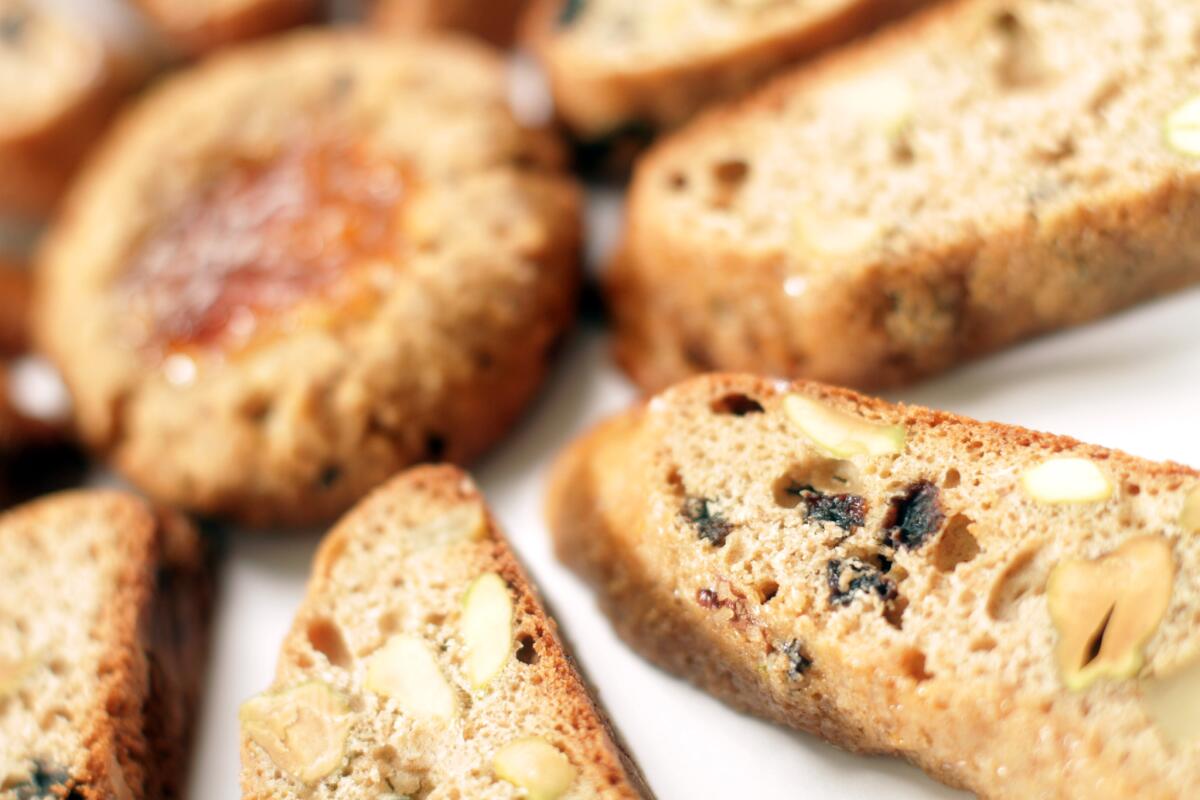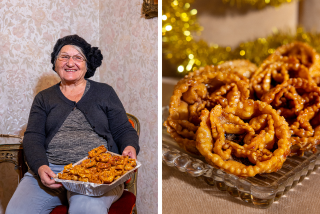How to bake your holiday cookies using whole grain flours

Holiday Spelt Biscotti around a Barley Thumbprint with honey and hazelnuts.
Amaranth, barley, millet, spelt and teff — you’ve probably seen these or other whole-grain flours showing up on store shelves as we become increasingly familiar with them and as they become more widely available. These are flours with distinct characters and subtle flavors, and they’re great to play with, especially during the holiday baking season. Baking cookies with whole-grain flours doesn’t have to mean wreaking havoc to family favorites, but rather adding new recipes to your repertoire. Here are recipes for three holiday classics — biscotti and thumbprint cookies, and a riff on the German spice cookie pfeffernüsse — each recalibrated for spelt, barley and teff flour, as well as a primer for baking with whole grains, to get you started.
RECIPES: Barley thumbprints | Teffernüsse | Holiday spelt biscotti
Spelt, an ancient wheat variety with a subtle nuttiness, is a wonderful flour to try in cookies. In my holiday spelt biscotti, you will be rewarded with an alluring aroma and a crisp crunch. In my native Germany, spelt has been used for centuries in traditional baked goods. The nutritious flour is lower in gluten and thus has to be handled a bit gently. It works well in a fruit and nut-studded biscotti, adding an extra boost of nutty flavor.
Barley is another terrific holiday baking flour because it adds hints of malt and a natural sweetness to your treats. In the barley thumbprints with honey and hazelnuts, the whole-grain flour is combined with toasted hazelnuts, honey and citrus zest, all of which give you a supremely fragrant cookie. This fiber-rich flour is also lower in gluten, so I recommend you only use barley to replace up to 25% of all-purpose flour by weight in your favorite recipes.
Teff, a traditional Ethiopian grain flour, has a dark hue and notes of cocoa. It’s beautifully suited to holiday baking, particularly in pfeffernüsse, a type of German gingerbread. I make a variation with teff that I call “teffernüsse” — the flour contributes a smooth, almost truffle-like richness to the classic cookies. Teff is also gluten-free (as are millet and amaranth), so be sure to replace only about 20% of your total flour by weight in a recipe if you want to avoid making the baked goods too heavy.
SIGN UP for the free In the Kitchen newsletter >>
Tips and tricks for baking with whole-grain flours include adding more liquid to the dough. Another thing that helps is to give the dough time to rest so that the bran in the flour can absorb that extra liquid — this can be extra water, milk or buttermilk — which makes for a softer and more appealing texture. It’s also worth investing in a basic digital scale with a tare feature. Measuring your ingredients by weight, rather than with unwieldy measuring cups, reduces uncertainties that can derail a baking project. (Different bakers may pack a cup differently, even when following the same instructions.) Weighing is especially important with whole-grain flours, where too much flour can result in dense, heavy baked goods. And why grams rather than ounces? There’s a reason why most bakers around the world use grams to scale recipes: It’s just easier. Try doubling or tripling 1 3/4 ounces of sugar or 5 3/8 ounces of flour, then do the math for tripling 50 grams of sugar. Because if you’re doing a lot of baking this time of year, worrying about math is not nearly as much fun as making, decorating — or eating — your holiday cookies.
Maria Speck is author of “Simply Ancient Grains” and “Ancient Grains for Modern Meals.”
More to Read
Eat your way across L.A.
Get our weekly Tasting Notes newsletter for reviews, news and more.
You may occasionally receive promotional content from the Los Angeles Times.










